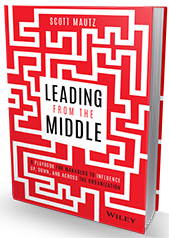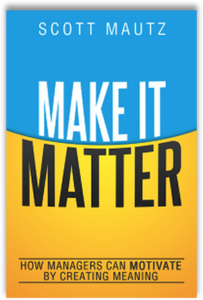
INSIGHTS (on leadership/self-leadership)
As I discuss in Leading from the Middle, the middle manager role is like none other in leadership, and it’s exhausting. The biggest reason why might surprise you – it’s not just the number of meetings.
When you lead up, down, and across, you wear more hats than you can keep track of. Middle manager exhaustion comes from the constant micro-switching, moving from one role to the other, all day long. And you’re constantly changing altitudes, engaging at various levels of the organization. One minute you’re adopting a deferential stance with your boss, the next you switch into a more assertive mode with your direct reports, then into collaborative mode with your peers (as shown below):

You switch from moments where you’re experiencing tremendous autonomy and a sense of control, to moments where you feel like a mere cog in a giant wheel with lots of responsibility but little authority and too little support. The range of issues and responsibilities is ever broadening, creating still more micro-transitions. Role switching fatigue is exacerbated when you have to perform in front of different levels of management or different functions within one meeting, or when you unexpectedly have to jump into one of your roles you weren’t mentally prepared to play.
The net result is exhaustion, frustration, and confusion about who you really are and what you should be spending your time doing, which is further exacerbated if you’re working in a poorly defined role with unclear expectations and uncertainty about how far your authority extends. And to cap it all off, all the micro-transitions that force you to be spread thin can leave you feeling that while you’re certainly busy, you’re uncertain of the impact you’re really having.
So, what to do about the micro-switching induced exhaustion? Try these two simple strategies.
1. Schedule “same altitude” meetings together. Remember, jumping up and down the organization to engage with different energies and approaches is energy-sapping. As author Lia Garvin says, not doing so, “reinforces the overwhelm of having to operate at so many different levels in one day.”
2. Reframe how you view your role. Take pride in leading from the middle. For example:
– You work not in an organization, but an organism. And you’re the lifeblood of it.
– The micro-transitions you’re constantly making aren’t segmented, they’re integrated. The 100 jobs you belong to add up to one vital job you’re uniquely suited to do well. Value the variety.
– You’re the keeper of the long and short-term flame, working on the business and in the business. This is a unique privilege that those leading from the middle experience.
– You’re a lighthouse and a beacon, signaling threats and drawing all towards opportunities. It’s a powerful duality.
IMPERFECTIONS (a mistake many make)
Berkshire Hathaway’s Annual Shareholder letter was recently released, featuring another deceivingly simple gem from the Oracle of Omaha himself, 94-year-old legend, Warren Buffett. Says Buffett in the letter:
During the 2019-23 period, I have used the words “mistake” or “error” 16 times in my letters to you. Many other huge companies have never used either word over that span. Amazon, I should acknowledge, made some brutally candid observations in its 2021 letter. Elsewhere, it has generally been happy talk and pictures. I have also been a director of large public companies at which “mistake” or “wrong” were forbidden words at board meetings or analyst calls. That taboo, implying managerial perfection, always made me nervous.
Buffett points out the importance of simply admitting your mistakes and being brutally candid about your needed areas of improvement. Resist the temptation to gloss over this as a mere platitude. Research shows that 95 percent of managers believe they’re self-aware, but only 10-15 percent, actually are. So, not only is it important to be more aware of mistakes you’re making, it’s just as important to admit to them, learn from them, embrace them as a key part of success, and to role-model acceptance of them accordingly.
IMPLEMENTATION (one research-backed strategy, tip, or tool)
For today’s overworked, underappreciated, under fire workforce, one skill, in particular, is shooting up the ranks in importance.
Empathetic Communication.
While I could teach a whole session on this (and do), I’ll share one central thought. The key to communicating with empathy, to your team/organization, is to meet them where they’re at. What are they going through? What would their lens be on what you’re about to share? How might you come from a place of knowing what it’s like when…? In fact, before you communicate to your group, on a topic you know will require an empathetic touch, use this fill-in-the-blank sentence to help you craft your message:
I know what it feels like when ____________, therefore I will ____________, to make them feel ____________.
Note the last two parts of this sentence. It’s not enough to just put yourself in your audience’s shoes, you also have to take specific action that will create the empathy-tinged feeling you want them to feel.




Leave a Reply